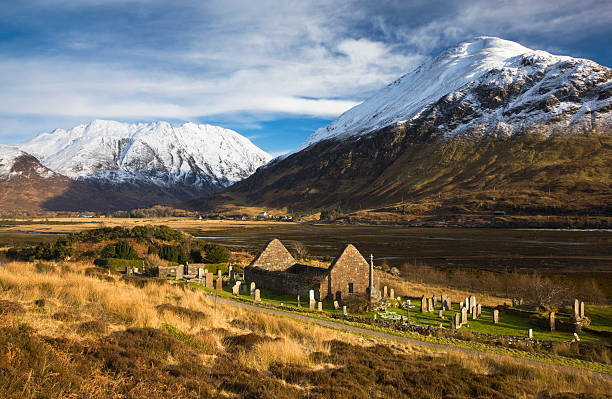
The Medieval Church in Alba
The Medieval Church is characterised by many things but the advent of Diocesan Structures and Parishes, both with well-defined boundaries, are probably the most obvious.
In the very earliest days, priests were supported 'voluntarily' by the tribes-people with whom they lived and served. These voluntary gifts were mostly in the form of produce and labour. But this was a tenuous means of support because it was very reliant on the abundance of the seasons and the generosity of the tribes-people (and perhaps also on the 'quality' of the priest and his 'popularity'). Some form of permanent support for the parish and its priest soon became a necessity and, as the Church developed, other clerics, who were not necessarily associated with any one fixed 'locus', needed to be provided for as well. The first move was to incorporate the priest into an agricultural partnership with the village community and to encourage this he was awarded a plot of land which came to be known as his glebe. In what was to become the kingdom of Scotland, certainly in the northern parts with which we are most interested, the glebe often amounted to a half-dabhach, but there are cases where it was a full dabhach. But since the dabhach was something of a 'moveable feast' there is no easy way of assessing and comparing the 'value' of glebes.
In general terms, the dabhach is taken to be equivalent to four Ploughgates or, on the West Coast, 20 Pennylands - a Ploughgate often being known as a Merkland, that is, sufficient land to generate an income of one Merk (13/4d. Scots). However, a dabhach in the highlands of Strathspey would be a very different thing from a dabhach in the salubrious surroundings of the Laigh of Moray! It was primarily a measure of value rather than of a specific area or acreage of land (although, in later financial systems, a ploughgate was approximated to 160 acres).
Obviously, for the parish priest, this gave him a good measure of independence.
But as needs grew so did the sources of parish revenue need to grow. The first document which enumerates the more general sources of ecclesiastical revenue comes from 'south of the Border', in an ordinance of King Athelstan1 commanding his officers to see that churches receive their plough-alms, cyric-sceat, and sawol-sceat (the church-scot and soul-scot of later documents). But this whole system of payments probably dates back to the seventh-century, well before Athelstan's time. It would be reasonable to suspect that a similar system would have advanced north of the Border after only a little time. The young Ian Cowan commented, "... the Church in England, as well as that in Scotland, tended to lag behind continental developments. Moreover, England and Scotland were in themselves not so utterly remote, as some would have us believe, and when changes did come to England, their transmission to Scotland was usually not unduly delayed."4
As the bishops in Scotland ceased to be episcopi vagantes they began to emulate the practices of bishops in other parts of Europe and gather an 'establishment' around them with which to carry out their new administrative duties. The first on the scene were usually the Archdeacons, then Chapters of canons, Cathedral functionaries, chaplains, vicars-choral, down to the choirboys - whose pay scales, interestingly, often came to be nearly on-a-par with some of the adults! Obviously, the financial demands made on 'the faithful' were increasing and they were often not very happy about the imposition!
In England, the parish system developed out of the network of mynster churches (matrix ecclesia) which acted as 'mother churches' to a group of subsidiary 'field churches' and/or 'chapels'. But in Scotland, certainly in the northern Diocese, the physical geography encountered prevented such a system from developing fully in all but a very few places. However, as the Parish descriptions presented on later pages show, many of our Parish Churches had sometimes quite far-flung chapels associated with them which were served by the Parish Church's priest(s).
At a very early date, monasteries came to be established within the dioceses, even in some relatively remote locations, and to these, in time, were added the houses of the mendicant orders, collegiate church establishments, hospitals and even hermitages. Our area of interest, the northern dioceses, had them all - but in moderation! However, in some of the cities, such as Elgin, there came to be a startling concentration of ecclesiastical establishments numbering more than one would expect for what was only ever a modest population in Medieval times.
Since the twelfth-century a continuous series of bishops can be traced in the thirteen dioceses whch had become established in what is now Scotland. However, we should remember that, for much of the Medieval period, two of these diocese were not part of Alba (Scotland) at all but were, both in ecclesiastical and secular terms, very much part of the Norwegian hegemony. The islands of Orkney and Shetland (the Northern Isles - Norðreyjar) were staunchly Norwegian up to the time that the King of Norway ceded them to the Scottish King in 1472. Likewise, what we now know as the Diocese of the Isles was Norwegian. It used to be much larger, encompassing not just the Western Isles but also Mull, Tiree, Coll, Jura, Islay (the Inner Hebrides), Arran, Bute and the Isle of Man. To the Norwegians this was Suðreyjar (Sodor) - the Southern Isles. When the southern half of Sodor was separated from the Isles, the northern territories established a cathedral at Snizort on the Island of Skye, before it was transferred to the Island of Hy (Iona). It may also be argued that the most northerly of the mainland dioceses, Caithness and Ross, were also outposts of the Norwegian Province, particularly in their very early history. However, they can be seen to have been part of the embryonic Scottish Province and so they are included in the list below.
| Name | Founded | Notes |
|---|---|---|
| Aberdeen | 1131x1132 | (c.99 parishes; 5 deaneries) Bishops Bean, Denortius, Cormac (episcopi vagantes) were found earlier at Mortlach, before any Diocesan structures were created in Scotland. |
| Argyll | 1183x1189 | (c.47 parishes; 5 deaneries) Suffragan of St Andrews from 14 Aug 1472 and translated to Glasgow 9 Jan 1492. |
| Brechin | c.1150 | (c.25 parishes; 0 deaneries) |
| Caithness | 1147x1151 | (c.23 parishes; 0 deaneries) |
| Dunblane | 1155 | (c.38 parishes; 0 deaneries) Originally a suffragan of St Andrews, it was translated to Glasgow 9 Jan 1492, but returned to St Andrews 28 Jan 1500. |
| Dunkeld | c.1114 or c.1120 | (c.71 parishes; 5 deaneries) A 'Celtic' bishop was known here in 865. Originally a suffragan of St Andrews it was translated to Glasgow 9 Jan 1492, but returned to St Andrews on or before 25 May 1515. |
| Galloway | 1128 | (c.48 parishes; 3 deaneries) York from 1128-1355. Suffragan of St Andrews then translated to Glasgow 9 Jan 1492. |
| Glasgow | c.1114x1118 | (c.250 parishes; 2 archdeaconries; 9 deaneries) Metropolitan Archbishopric from 9 Jan 1492. |
| The Isles | before 1079 | (c.48 parishes; 0 deaneries) Encompassed the islands of Skye; Man; the Isles; Sudreys; Sodor. Suffragan of St Andrews 14 Aug 1472 then Glasgow by 1617. |
| Moray | c.1114 or c.1120 | (c.73 parishes; 4 deaneries) |
| Orkney | before 1035 | (c.68 parishes)3 Suffragan of York early 11th century; Hamburg-Bremen 1043x1072; Lund (?) c.1112; Nidaros-Trondheim 1153; finally St Andrews 17 Aug 1468-9. |
| Ross | 1127x1131(?) | (c.40 parishes; 0 deaneries) Bishops (episcopi vagantes) found in the area from at least 1065 (e.g. St Duthac). |
| St Andrews | before 1055 | (c.267 parishes; 2 archdeaconries; 8 deaneries) Metropolitan Archbishopric from 14 Aug 1472. Primacy from 1487. |
The cathedrals of Scotland were, with the exception of St Andrews and Whithorn, governed by a Chapter consisting of secular priests known as canons. Whithorn was governed by a Chapter of Premonstratensian canons regular, or monks, whilst that of St Andrews was, firstly, composed of individuals described as Céli Dé, who were later supplanted by canons regular of the Augustinian Order.
References.
1. I Athelstan, c.4. The term tithe is also mentioned in this document, but the king does not indicate its destination.
2. Watt, D.E.R. (1969) Fasti Ecclesiæ Scoticanæ Medii Aevi: ad Annum 1638. St Andrews: St Salvator's College.
3. The bishop was based in Orkney whilst the archdeacon was located in Shetland (Zetland).
4. Cowan I B (1961), Appropriation of Parish Churches in Medieval Scotland, unpublished PhD thesis, Edinburgh University, Vol. I, p.21.
 Return to top of page
Return to top of page